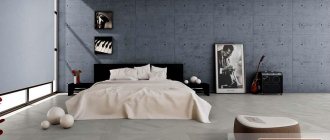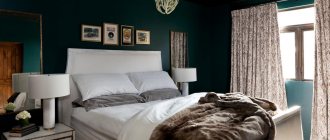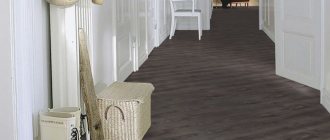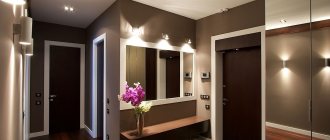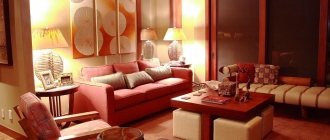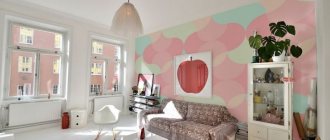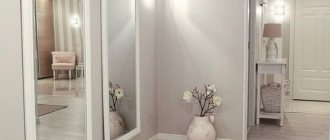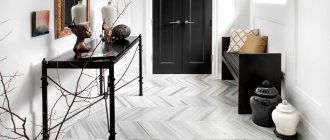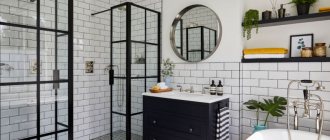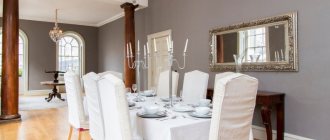What influences the choice of color in the hallway
The corridor is a place for light colors, unless otherwise provided by the overall design or original design. Due to the lack of windows (which is typical for almost all hallways) and compact size, it is customary to brighten corridors with the help of walls and rich artificial lighting. Searching for objects in a dark room is not very pleasant, so some people simply leave the light on all day long. If everything is clear with the ceiling - it should be light, then the color scheme of the walls depends on the lighting, textures, the presence of textured surfaces, and the need for combining shades. Size, of course, has its influence. In narrow spaces, light cannot spread well due to the darkness created by the walls. Pieces of furniture will cast shadows. So all these nuances should be considered along with the definition of the pros and cons of light or dark design.
Previous design experience is not always objective, because materials are constantly being improved, but it will definitely help you decide whether to use a particular color.
Hallway size
The shape of the entrance space tends either to be rectangular, as in two- and three-room apartments in Brezhnevka apartments, or it is square, as in most Khrushchev-era apartments. The optimal minimum width is 1.4 meters, and length - from 2.5. In such a corridor you can install modular systems and open storage. Hallways that are already 1 meter wide are almost always expanded, all that is needed is technical capability. Building codes provide for a width of 1.2 meters for places where the hallway opens into other rooms, and sections that are already a meter long are no more than one and a half meters long. All hallways consist of 2 parts - a reception area and an area for arranging communications. It wouldn’t hurt to find a place for a sofa, and in the spacious corridor of a multi-room apartment - for a large guest area similar to the hall. In locks with a height reduction of up to 2 meters, mezzanines are made.
Combination of materials
The hallway is decorated with one material or nice combinations. The first of these should be noted is the combination of wall panels and wallpaper. The walls of the loft hallway are decorated with whitewash and textured coverings, and sometimes bare walls with remnants of torn wallpaper are added to this ensemble. The technique of abruptly interrupting the brickwork has become traditional. In the classic version, elegant combinations are created with wallpaper, plaster, tiles and stone surfaces. Interiors in a modern style are made with the combined use of glossy, matte and satin finishes. The walls combine materials with a pleasant texture. Wood is combined with plastic and mirror polystyrene. Bamboo panels can be seen next to stone surfaces. The hallways are also finished with different types of wood coverings. Heterogeneous finishes, among other things, are used for zoning.
Texture and print of finishing
Some types of textures:
- Flat;
- Rough;
- Patterned;
- Geometric.
The corridor is usually left without a pattern if it is finished with panels. Oblong and compact planks are smooth and faceted in texture. Patterns usually cover glossy surfaces. Drawings and prints “get” into the corridors on regular and photo wallpapers, 3D compositions, panel films and painted walls. Fans of texture and color variety on surfaces should take a closer look at plastic. Imitations are made from the material, copying any raw material and repeating any colors. At first glance, natural wood, metal and stone cannot be distinguished from their plastic counterparts. Natural and synthetic materials are often painted white, creating solid monotonous surfaces. All those who like to personally participate in the design of their home should pay attention to paintable wallpaper.
Hallway illumination
A lack of light means a dull and unclear environment. Therefore, the corridor is either illuminated with several modern lamp options or with huge chandeliers. The main and additional devices of the modern type are mounted mainly on the ceiling, but extended versions such as linear ones are also installed on the walls. Wall sconces, which have recently appeared in any form, are also hung there. Products in a modern style look like boxes. They are assembled into compositions, directing light in different directions and using square and elongated devices. Grilyato ceiling systems have proven to be effective. Then a few spotlights on the walls are enough. Horizontal surfaces provide the best location for bendable strip lights with LED sources. In turn, the natural flow of light is organized through transparent doors or the absence of curtains in the interior passages.
Finishing styles and their inherent tones
The following interior styles are popular:
- classic;
- modern;
- retro and vintage;
- scandi;
- high tech;
- country/provincial.
Hallways usually do not have a lot of furniture, so maintaining the style will be easier than it seems at first glance. In the corridor, they usually try to enhance natural and artificial lighting. It is logical that white color dominates in most decisions. Pale yellow, orange, brown and gray come in second place. As for individual styles, in almost all cases additional colors should be used. In the classic design, simple white and some inexpressive light shade will suffice to emphasize individual elements. It’s hard to imagine high-tech and modern style without gray walls. Various options are possible, including solid, multi-colored and combining several walls in different colors. Light shades of different colors are typical for country, but in retro style they use all the variety.
Classic style
The entrance room in the spirit of classics is always made light. Combinations of white, cream, beige, silver, lemon, light green and other colors that logically fit into this range are used to the fullest. The walls are made in white or cream color - this is almost a mandatory technique if some kind of pattern is not provided. Structural elements of classic decoration and interior items usually represent a tonal range. The classic style allows for patterns in dirty tones. This emphasizes the nobility of classic shades. In an expensive interior, the palette can be formed around gold and silver colors. Mirrors, crystal, and precious stones harmonize perfectly with them. The interior should play with colors in the eyes of a person moving along the corridor. Furniture for the hallway is bought a little darker than the walls. The reverse contrast is adhered to much less frequently. The lighting is made saturated, but technological devices are completely ignored.
Modern style
Modern design principles give complete freedom of action. At the same time, trends are moving deeper into technology. There is a “demand” for an abundance of colorful lines and transitions. Wide and narrow, long and short, straight and curved, continuous and intermittent. Creative people and designers form masterpieces from them in one copy. A special color geometry is placed on the walls. The ceiling and floor are made simple to separate these compositions. But sometimes the finish “transitions” from the walls to other surfaces. It is better to diversify non-standard housing with dark walls. In other cases, they opt for a light finish with a gray tint. A modern style hallway usually contains noticeable color contrasts. For example, walls and doors, several different walls, furniture and decoration. Color inserts and several paintings representing past eras in painting will not be superfluous.
Retro style
Retro is a conventional cultural philosophy of using out-of-date items and color palettes. Designers play on the inconsistency with modern trends. Sometimes according to the principle “the new is the forgotten old.” The walls are given color using old faded wallpaper. They choose authentic products from the 80s and 90s. The color scheme usually includes grey, pink and blue. Retro, as the embodiment of old avant-gardeism, welcomes a variegated multi-colored range, and at the same time it can only be done in white or gray. If something happens, you can go with the win-win striped option. Striped walls look good against the background of a checkerboard floor. Painted walls in one color look good with vintage items. Simple modern finishes will go unnoticed behind antique pieces. The color of the walls in the hallway can be contrasted with the design of the apartment.
Scandinavian style
The referral leaves residents without most options. Not only is white required, but the shade must also be pure. For this reason, they make a slight deviation and add cream color and pale tones of the spectral circle. An all-white Scandi-style hallway will look like a hospital hallway if you don't add some colorful pieces. In general, surfaces are freed from everything superfluous, by analogy with a minimalist setting, but the walls of a Scandinavian interior are decorated with anything. These are bicycles, and lonely hangers with suits, and anything else. The style allows the use of wooden materials. Wood-trimmed walls will become a natural part of the interior. These are almost all alternatives to the “snow-white” design. Thus, the corridor in the spirit of Scandinavia is either painted or trimmed with white or brown panels.
High tech
The style of high technology is conveyed using:
- smooth surfaces;
- glass and mirrors;
- metal and plastic.
Bright colors should not be used. At the same time, you cannot absurdly throw white, gray and brown into a heap. Colorful combinations will deprive the interior of its technology. In turn, solid white and gray walls look great together with technological furnishing elements. Sometimes the color is diluted with even stripes located without geometric patterns. The walls are given a striped structure using panels. The high-tech style in the interior is associated with complex architectural forms. These include a variety of partition walls in an unusual geometric design. Elements of partitions can be painted in any shade, even acidic. It is enough to collect something interesting and designer once, and it will decorate the house for a long time. High-tech can be developed into more specific directions, for example, into a space style with a dominance of blue and purple.
Country style
The walls are made in soft shades of any color, and any materials and textures are suitable for finishing. The shades are mostly pastel to match the furniture - slightly shabby and simple. Country style provides opportunities to create a beautiful, subtle environment without components that look presentable on their own. For example, careless or aged furniture is placed against a wall with an unremarkable or even unpleasant color. The composition will ultimately look harmonious and attractive. There is no need to rack your brains over what to do with neat finishing in a modern style if the hallway originally looked like this. There are many furniture options, and their light colors mean a wide range of textures. Traditional country colors include brown, gray, olive, turquoise, lilac, blue, pink and ivory. The provincial setting allows for finishing with wallpaper, clinker bricks, and relief plaster.
Other shades that are suitable for country:
- cocoa;
- lavender flowers;
- lime;
- nut
What paints should I use?
To use paint and varnish material in a hallway or corridor, it is necessary to pay attention to the basic qualities and characteristics of the paint, since this will ensure long-term operation of the coatings, protect the walls from mechanical loads, the influence of liquids and other contaminants characteristic of this room.
Features of corridors and hallways:
- Location near the front door, which implies frequent sudden changes in microclimate and temperature, drafts. This destroys the coating with insufficient elasticity.
- Outerwear, shoes, umbrellas, and hats are often removed and left in the hallway or corridor. In bad weather, these things are often wet and dirty, which, as a result of moisture coming into contact with the walls, will directly put a load on the surface of the walls located close to the hangers. Paint and varnish coatings must have good wear resistance.
- Through the corridor and hallway, all objects enter the apartment: furniture, other large items. It is rarely possible to apply them without damaging the walls as a result of impact or friction, so the paint must form a durable film.
- Due to the openness of corridors and hallways to other rooms and spaces in the apartment, owners have to come into contact with evaporation from the walls, which should not be toxic or harmful. Intermediate spaces should be painted with paints intended for use in residential buildings.
The best paints for decorating walls in hallways and corridors are water-dispersed paint compositions. They have all the necessary properties and are vapor permeable. Let's consider the types of this category of material.
Acrylic
High-quality but expensive paints and varnishes for interior decoration. They are resistant to direct exposure to UV radiation, vapor and moisture permeability, and film strength.
Due to its high drying speed and color retention, regardless of the operating conditions of the room, the paint forms a soft, even coating that can hide even small cracks as a result of painting.
Butadiene styrene
Budget materials that are suitable only for interior work in rooms exposed to moisture, liquids, and other contaminants on the walls. It is necessary to take into account that the paints of this series are not resistant to sunlight.
As a result of prolonged contact with UV radiation, surfaces painted with water-based butadiene styrene paints acquire a pronounced yellow tint.
Polyvinyl acetate
These paint and varnish compositions are cheap, with the most modest moisture resistance indicators. They should be used in rooms where contact with moisture is minimized.
Alkyd enamel
The peculiarity of the coloring composition is the presence of toxins of organic origin. When painting a room, a persistent, very unpleasant characteristic odor is created. To eliminate this effect, you need to intensively ventilate the treated rooms for at least 3-5 days.
You can find odorless alkyd enamels at a higher price due to the composition with polyurethane-based additives.
Photo of dark corridors in the apartment
A dark palette allows you to set a certain shape and mood for the room, as well as impart nobility and sophistication to the interior.
Finishing materials in dark colors will provide an excellent background for furniture items. Such a rich color scheme does not create dissonance in the room and highlights every item and accessory in the room, giving them a clearer look.
Dark walls become an advantageous addition to a corridor in fusion, art deco or other eclectic styles, characterized by bright contrasts and a combination of incongruous elements.
The photo shows a large hallway in dark shades in the interior of the apartment.
It is believed that black shades make the atmosphere gloomy and visually make the room smaller, so such colors would be extremely inappropriate for decorating a small hallway. However, a spacious corridor in black, in combination with well-chosen furniture and proper lighting, will look very fashionable, expensive and elegant.
Dark tones have invaluable beauty, are distinguished by originality and aesthetics. In the design of the corridor, it is important to use deep cobalt, dark blue, complex purple colors or mysterious shades of indigo, which give the enclosed space a certain depth.
An expressive burgundy color scheme will add special aesthetics and sophistication to the decor.
Hallways in light colors
One of the main advantages of a light color scheme is its ability to visually expand spatial boundaries and make the room brighter and more comfortable.
This palette goes well with all shades. Against the background of a light wall covering, various decor and accent details look more advantageous.
The photo shows the design of a hallway with light walls covered with peach-colored paint.
Pastel colors fill the room with calm, cleanliness and freshness. An entrance hall in soft blue, lilac, pale green or ivory tones always has a well-groomed and pleasant appearance, and also has a warm and homely atmosphere.
Painting the walls a neutral beige or light gray will make a small space feel much larger and larger.
The photo shows the blue and white decoration of a small corridor in the apartment.
Brown corridor
Chocolate color combined with wood texture will create a respectable corridor design. Brown is considered a classic choice for people with conservative tastes.
The most popular color solutions include coffee colors, shades of cocoa or cinnamon, which have extraordinary softness and warmth.
The photo shows brown colors in the design of a spacious corridor.
Hallway in gray tones
The corridor in gray has a rich range that harmoniously combines with other tones. Thanks to such combinations, the interior will never be oppressive and faceless.
Gray is quite practical. Metallic, graphite, pearl colors or a shade of wet asphalt have a positive effect on the environment, promote relaxation and relieve tension.
For decoration, it is better to use a lighter ash and smoky palette. Such a hallway in gray always looks airy, fresh and spacious.
The photo shows the interior of a modern hallway in gray tones.
Hallway in white
Snow-white colors fill the corridor space with cleanliness, volume, comfort and give dark furniture or decor additional brightness and attractiveness.
Just as outerwear and sometimes dirty or wet shoes are removed in the corridor, the white design will quickly lose its impeccable appearance. Therefore, ivory shades are suitable as an alternative option. They look rich, harmonize well with other colors and add presentability to the interior.
The photo shows the design of a corridor made in white.
Mint color in the hallway interior
If you choose the right companion colors for the delicate mint color scheme, you will be able to create a fairly harmonious color composition that will match the dimensions and decor of the room.
The mint palette is effectively combined with white, grey, blue or gold tones. For modern design, a combination with red would be appropriate.
Hallway in beige tones
The most comfortable and warm color that fits perfectly into the corridor space and creates a pleasant atmosphere in the room.
Beige walls will go well with floor or ceiling cladding in restrained and natural brown, white or gray tones.
The photo shows a corridor in beige shades with splashes of white.
Turquoise color hallway
The turquoise interior is original and catchy. The natural shade of turquoise, combining heavenly radiance and sea waves, gives the atmosphere an attractive charm and freshness. This color gives the hallway a discreet luxury, and thanks to different color duets it allows you to create an interesting visual effect in the room.
Hallway ideas in bright colors
The hallway in an apartment or house is a great place to create expressive touches and bold color experiments. Extraordinary color solutions due to a short stay in the hallway will only have a positive effect on the surrounding space and add special tone and effectiveness to it.
For example, bright red tones will not leave anyone indifferent and will undoubtedly attract attention, orange will create an optimistic, positive and bright atmosphere in the corridor, and pink will at the same time add richness, solidity and intimacy to the hallway.
Yellow, lemon or mustard colors have a charming warmth and, due to their good compatibility with other color palettes, provide the opportunity to realize original design ideas and ideas.
The photo shows the interior of the corridor, decorated in red.
Light and color
The next factor influencing the main tone of the hallway is its illumination. The main thing here is to follow the rule: the brightness of the walls is directly proportional to the amount of light in the room.
If the hallway has a window facing the sunny side, or the lighting scenario is well thought out, then the choice can be made in favor of:
- blue;
- green;
- indigo;
- sea green;
- turquoise;
- purple.
A dimly lit hallway should be decorated in light colors. What designers do not advise doing is choosing white, since in low light it becomes dull and, over time, also “dirty.” White is a “reflector” of daylight, and when there is nothing to reflect in your hallway, it is better to give preference to another shade.
How to combine colors in the hallway
When decorating any room, you need to be guided by the “three-color rule.” This means that you need to decide which color will become the main color and which two will be additional.
If the hallway is designed in a neutral color and without bright accents, then you can choose combinations of colors similar in palette, for example: milky and beige, brown and gray, turquoise and blue. Soft transitions from one color to another will not irritate or bother you.
In cases where contrast is required, white will be an excellent match for any of the bright colors. The combination of walls in rich, rich colors and white furniture and doors looks very impressive. In such cases, it is better to make the ceiling and floor neutral: for example, bright yellow walls will harmoniously combine with a grayish ceiling and light gray-brown flooring. If the furniture is bright, then the best background for it will be light walls - for example, in a light gray hallway you can “settle” a cheerful green wardrobe or an orange pouf.
Accessories in black, dark brown or dark gray will help create contrast in the interior. They can be unusual modern lamps, an original hanger for outerwear, as well as framing pictures or mirrors.
Textures and prints
Do not forget that the textures of finishing materials can also help achieve the desired visual effect. Nowadays, wall decoration with natural wood is gaining popularity, since it is not only an environmentally friendly material - it does not require perfectly aligned walls, and well-chosen shade and pattern of wooden panels will help expand the space of a small hallway, making it cozy and warm.
Decorative brick and plaster finishing does not lose its position, but it will look better in large hallways, where there is a need for zoning and you don’t have to be afraid that the finishing material will “steal” a certain amount of space.
It is also worth paying attention to the ombre effect, which will help make the hallway unique.
As for prints, when decorating a hallway they can both play a cruel joke and correct the shortcomings of the room. So, horizontal stripes will visually expand the space, and vertical ones will raise the ceiling a little higher (a white horizontal stripe on the wall along the ceiling has about the same effect). But it is better to avoid overly variegated or large patterns - they will visually make the hallway smaller and will most likely quickly begin to get on your nerves. More useful interior design tips →
Decoration for a small hallway
Small rooms require a particularly careful design approach. What color should I paint the room? It is not recommended to make the walls in such hallways monochromatic. For visual expansion, it is recommended to use horizontal stripes. Vertical lines will correct low ceilings, visually lifting them. The pattern does not always have to be straight lines; a pattern directed horizontally or vertically is sufficient.
The color scheme in a small corridor should not be too dark. It is best to paint in light cinnamon and beige shades with white and off-white trim. An interesting solution would be white and brown striped teeth. A white horizontal stripe on the wall under the ceiling will visually raise it. You can also use mirrors and metal trim pieces to expand the space.
Small rooms are very capricious in terms of design. The emphasis should be on functionality, but at the same time avoiding exaggerated minimalism.
Natural materials look good in a small apartment. Light wood trim will create a warm and cozy atmosphere, and if installed correctly, it will last for many years.
Related article: Unusual country hallway - variety of style
Choosing the right wall color
In most cases, hallways are small. Basically, these are square or elongated rooms. The small area limits the choice, but there are criteria that should be taken into account:
- Area and layout of the premises. The smaller the hallway, the brighter the interior should be. A large corridor in a private house can be decorated in shades of dark colors, but for a small room it is worth choosing lighter shades.
- A stylistic direction that is used for interior design. Each style has characteristic features that you need to use to create a beautiful and stylish hallway.
- Features of the layout. In order to visually reduce a long corridor or increase the height of the ceilings, you should choose wallpaper with vertical stripes. To lengthen the room, a horizontal strip on the walls is suitable.
- Lighting affects the overall perception of the interior. Many corridors lack windows; the lack of natural light can be compensated for by placing artificial light sources. Good light will help highlight the color of the walls.
- It is not recommended to use more than 3 shades to decorate a hallway.
When choosing materials, it is worth considering the load on this functional area. Every day residents leave the house and return back. Depending on weather conditions, wet clothes, dirty shoes and wet umbrellas may appear in the hallway. Preference should be given to materials that are resistant to dirt and moisture. It would be appropriate to replace the snow-white shade of the walls with beige or cream.
Universal colors, their features
The hallway connects the apartment or house with the outside world. Only the necessary furniture intended for storing clothes is placed in a small area. You can decorate the room by decorating the walls and using a small number of decorative elements.
As the main color, you should choose universal shades that look harmonious in any interior; you can easily match them with bright decor. The main color should occupy about 70% of the entire interior, the number of bright spots should not exceed 30%.
Universal shades that are perfect for hallway design include:
- light yellow;
- beige;
- sand;
- terracotta;
- cream;
- peach;
- mint;
- grey;
- pearl gray;
- coffee with milk;
- lilac.
Gray tones combined with beige, many mirror surfaces, and white accents allow you to create a stylish interior. Gloss and many mirrors visually increase the space. Depending on what effect you want to achieve, you should decide what color to paint the corridor.
Shades of bright colors enliven the interior and give it a mood. Painted mustard walls highlight the neutral beige doors and brown wardrobe. Despite the lack of lighting, the hallway is warm and cozy.
The optimal solution for decorating a hallway is natural shades chosen for the base, and bright spots that dilute the boring design. The living space, the design of which is made in a single color scheme, looks stylish and complete.
The color difference allows you to harmonize the interior, which also gives the interior a sense of dynamics. For this purpose, various combined colors or several shades of the same color are suitable.
Backlight
Lighting is used to zone rooms or create accents on certain details. A place with mandatory enhanced lighting is next to the mirror. You can experiment with other areas of the corridor.
Colored lighting in a hallway with plain walls will create a completely different mood. And the color of the lamp is easy to change if desired.
The color of the light source also plays an important role. Green is best used in the relaxation area, golden or pinkish in front of the mirror. Cool tones visually expand the rooms. Movable lighting fixtures will create an interesting effect in any functional area.
Before choosing what color to paint the hallway, you need to take into account all the functional features so that the color scheme improves the appearance of the hallway. A good hallway interior is very important because it sets the mood when you enter your home.
Article on the topic: Design of a corridor in an apartment (+50 photos)
Hallway in white and brown tones (2 videos)
Color options for the hallway (38 photos)
Classic style - colors for walls
When you need to design an interior that will remain relevant for a long time, you should give preference to the classic style. This direction is characterized by rigor, elegance and functionality. Natural materials are ideal for finishing and decorating a room:
- Fine wood or stone tiles, such as marble, are suitable for the floor.
- They make stucco on the ceiling.
- It is better to choose plaster cornices.
- For walls, paint with a matte finish, wallpaper with ornaments, and decorative plaster are suitable.
Designers advise painting the walls in the corridor:
- white;
- gray;
- beige;
- olive;
- burgundy;
- brown;
- purple.
The classic style welcomes light and muted colors. Plain wallpaper, Venetian plaster, and paint are suitable for wall decoration. The hallway should be painted in a single color scheme; the material may contain a light pattern or design.
Carvings, columns and stucco will help complement the monochromatic design. Also, as decoration you can use natural materials, mirrors, luxurious wall lamps, which will be combined with the main lighting fixtures in the corridor.
In the presented version, the walls are painted with beige paint, and black and white tiles with squares were used to decorate the floor. Mirrored cabinet doors increase the space and, by reflecting the flow of light, create interesting shimmers. To decorate the hallway, we hung a luxurious chandelier and installed a decorative vase in the corner.
Light shades are better than others for decorating a hallway in a classic style. In combination with light furniture and decorative elements, the interior looks luxurious and majestic.
Shades of dark colors can be used for spacious hallways. It is important to provide good lighting that will highlight the chosen wall color or pattern.
The walls of a traditional classic hallway are predominantly light and warm. All details are harmoniously combined with each other; there are many unusual and beautiful decorative elements in the room. Neoclassicism is characterized by a wider range of colors. Contrasting colors and bright details can be used.
Preparing the walls for painting
In order for repair operations to be completed successfully, the surface must be prepared. Painting the walls in the corridor involves working with as smooth an area as possible so that the dye adheres perfectly and does not emphasize unevenness. Preparatory activities are carried out according to the following algorithm:
- The old covering is dismantled. The paint is removed with a solvent and a scraper. To remove wallpaper you will need a grinder with a wire brush. You can also use a spatula and water.
- A thorough inspection of the cleaned surface is carried out to identify flaws. They can be removed using putty and a spatula. The peeling plaster is beaten off, and the cracks that appear are sealed with a solution of cement and putty.
- Then the surface is leveled using gypsum putty. Then you should wait until it dries.
- We treat the surface with a finishing putty mixture.
- After drying with a grater and sandpaper, the workspace is rubbed and sanded to perfect smoothness.
- Dust is removed with a vacuum cleaner. A rag removes debris.
- A primer is applied to the surface for painting.
Please note: Methods for removing paint from ceilings
After the preparatory work, the “soil” should be allowed to dry. Then you can move on to basic manipulations.
The first step is to remove the old coating
If necessary, the walls are leveled and then primed
Choosing a color for a narrow hallway
The main task of designing a narrow hallway is the correct placement of furniture and visual expansion of the space. Light color of the walls and ceiling will help to visually raise the ceiling. Enlarged doorways will add solemnity to a narrow hallway.
By using zoning for the entrance and lobby areas, you can create the correct proportions in the room. Different stylistic directions, light, color, floor and ceiling finishing will allow you to highlight functional areas.
To visually expand the space, you can use mirror and reflective surfaces. Mirror inserts can decorate interior doors, and the closet can be decorated with reflective elements. Even mirror tiles are suitable for wall decoration.
It is not recommended to use material with a large pattern or elongated pattern to cover walls; you should give preference to a monochromatic design.
Narrow hallway decor
This room has a number of features. If you follow them, you will be able to avoid the most common mistakes when creating a design.
It is recommended to adhere to the following tips:
- It is better to use paint as a coating, as it can be easily washed and difficult to damage.
- It is necessary to add as much light as possible; wall or ceiling lamps are suitable for this.
- Furniture should be placed along the walls - it should not create inconvenience when moving.
Related article: Hallway interior: color and design (+30 photos)
For a narrow hallway, the color of wallpaper or paint should be chosen according to several principles. The main one is simplicity. Due to the lack of space, such a hall can easily be oversaturated with an abundance of colors and shades, so choose plain materials. You can take a closer look at cool pastel shades. Combining a dark base with white elements on it will help add drama.
Try to avoid boring. Monotonous interiors quickly become boring. Therefore, you should use various techniques, for example, a smooth transition from lighter to darker colors.
conclusions
Correctly selected furniture, light pastel shades of the walls, and decorative elements will help you create a beautiful, stylish, modern hallway.
Design and selection of furniture should be carried out in advance. You can beautifully paint the walls in the corridor with the help of craftsmen or with your own hands.
It should be taken into account that the use of mirror surfaces and light shades will help visually enlarge a small room.
To create coziness and comfort in the hallway, to give it functionality, you should use many sources of artificial light, space zoning, and mirror surfaces. The design should correspond to the tastes of the owners of the apartment or house and be comfortable for them.
A modern corridor is a stylish, modern, comfortable, multifunctional room, taking into account the necessary factors influencing its purpose. We hope it is now clear what color to paint the walls in the corridor.
Selecting wall finishes
For the hallway you can choose several types of covering:
- Wallpaper is a universal finishing option. To understand what color of wallpaper to choose for the hallway, you need to decide on its type. The saturation and brightness of a particular color will depend on this indicator. For such a room, it is better to buy moisture-resistant wallpaper, since wet and snow-covered things may come into contact with the walls.
- Paint - this option is quite practical and durable. For a good coating, careful preparation should be carried out - priming and sanding the walls in the hallway.
- Water-based paint is a durable coating that is easy to clean from dirt. Usually water emulsion is sold in one color - white. Next, it is combined with a color scheme, so the intensity of the shade can be adjusted.
In general, you should take into account the overall style of the room and select a covering that can match it.
On video: how to choose paint color for walls.
What does it look like in the photo?
In the following photo you can see what the painted room looks like.
